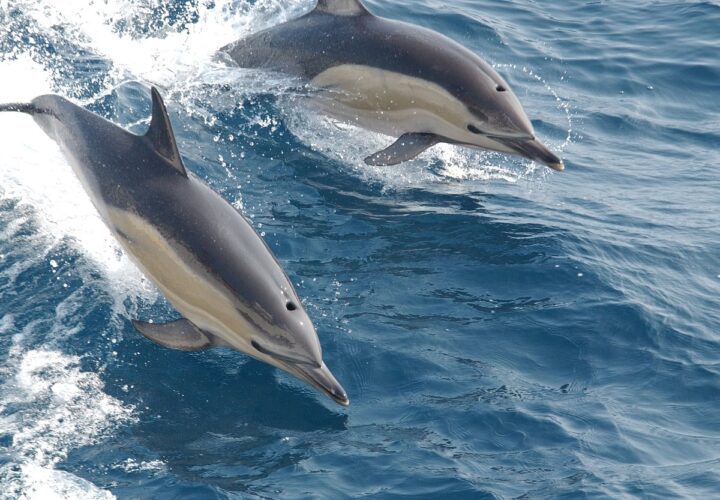Lead researcher and neurology professor at the University of Miami Dr. Deborah Mash is studying the link between Alzheimer’s signs in dolphins and humans. Her team joined forces with researchers from the Rosenstiel School of Marine and Atmospheric Science and discovered that beached dolphins’ brains exhibited signs of beta-amyloid, the toxic protein that many researchers think leads to Alzheimer’s symptoms.
In addition to beta-amyloid, the scientists found that the dolphins had been exposed to cyanobacterial blooms that come from toxic algae. This bacteria has been found in contaminated drinking water and certain fish. The recent discovery caused the researchers to conclude that some aquatic creatures we ingest might affect our brain. The study supports previous research that explored a connection between cyanobacteria and neurodegenerative conditions like Alzheimer’s. Mash thinks that if we avoid certain types of seafood or eat it in moderation, we are less likely to be exposed to toxic substances that could harm the brain. However, more research needs to be done to determine whether cyanobacterial exposure is causing Alzheimer’s symptoms.
- The toxin beta-Methylamino-L-alanine (BMAA) is found in algae, which bottom feeders eat
- Mash’s research suggests we should consume small amounts of bottom feeders including lobsters, crabs, shrimp and shellfish
- More research needs to be done, but scientists advocate for donating your brain to help them better understand whether toxic algae exposure could lead to an Alzheimer’s diagnosis
Being Patient spoke with Mash about how this discovery came to existence, what can be done now to protect our brain health and what future studies will focus on.
The Link Between Dolphins and Humans with Alzheimer’s
Being Patient: What encouraged your team to start looking for Alzheimer’s disease in dolphins?
Dr. Deborah Mash: Dr. Paul Alan Cox wanted to understand why there was a high population of people from Guam with a disorder called amyotrophic lateral sclerosis-parkinsonism-
We did a collaborative study with colleagues at the Rosenstiel School of Marine and Atmospheric Science, and we started looking at the marine food web. We tested various sea life from all complex levels of the marine food web, and it led us to dolphins. Dolphins have high concentrations of methylmercury in them. BMAA is toxin synergistic with methylmercury, so now we have comparable toxins.
Being Patient: How is this toxin getting into the marine food system?
Deborah Mash: It comes from blue-green algae, and it is concentrated in the bottom feeders like shrimp or lobsters because bottom feeders eat algae, and dolphins eat the bottom feeders.
Being Patient: Take us through your study. How did you select the dolphins, and what did you see in the dolphins’ brains?
Deborah Mash: We received dolphin tissues from dolphins that were beached. The collection of dolphin brains were studied in our laboratories, and we did an anatomical work-up on these cases similar to what neuropathologists would do on human brains after death to diagnose Alzheimer’s.
Being Patient: So the fact that they were beached meant that you could do autopsies on the brain, and that is where you saw the presence of the bacteria?
Deborah Mash: Yes, and that is where we were able to measure the BMAA, toxins and mercury in the brain of the dolphins. We did a full neuropathological work-up and sectioned off the brain exactly according to protocols. We did different steps in our scientific study, even extra steps to make certain that what we were looking at in the dolphin brain really resembled the pathology we see in the human brain.
Being Patient: Did you see more amyloid plaques in the dolphins’ brains? Is it the same type of plaque we see in the human brain?
Deborah Mash: Yes, we did, but I cannot say the plaques are identical to the human brain, but we believe that they are. We also believe the pathology of the human and dolphin brain are similar.
Future Studies on How BMAA Impacts the Brain
Being Patient: Why do your findings matter? What do they mean in the spectrum of research for humans and looking for an Alzheimer’s cure?
Deborah Mash: The takeaway is to stay healthy. Our genetics are not completely our destiny. I eat shrimp, which are bottom feeders, but I try to eat them rarely. We had someone who lived in the Florida Keys donate their brain and he had ALS, which has features of frontotemporal dementia (FTD). He ate bottom feeders very frequently, especially lobster, so when he died, scientists studied lobsters that were kept in his freezer. The lobsters had BMAA, so do not eat too many bottom feeders. That would be my message.
Being Patient: Where is the dolphin study going from here? Have we concluded what we needed to conclude or are we moving on to dig deeper?
Deborah Mash: We have to replicate. Any good scientist is going to tell you to replicate. We also need additional studies, and to look at dolphins around the planet. This is where bio-repositories are important, and this is why donating your brain after death is important because we are learning more about the genetics of the brain. The brain is the next biological frontier. We learned more about the brain in the last 20 years than we ever did in history. The only way we will be certain is if we do large-scale studies, and at the same time, we need to understand why these toxins could be causal by the disorder if indeed they are.

This was so interesting!! Is there a protocol for removing toxins that from the body that we should follow on a regular basis?
Vickey